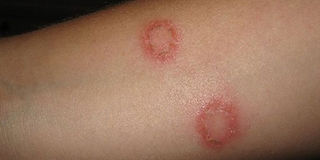How to deal with fungal skin infections

Ringworms can occur at any age, but mostly affects children and goes away at puberty.
Fungal skin infections are infections of the skin caused by dermatophytes and yeasts, which are groups of fungi that are normally harmless. When these grow excessively, they can cause the symptoms of a fungal skin infection.
Fungal skin infections usually affect your skin because they live off keratin, a protein that makes up your skin, hair and nails. It’s estimated that one in four people worldwide have a fungal skin infection.
Fungal skin infections are divided into different groups depending on what type of fungus is involved.
Types of fungal skin infections
Some common fungal skin infections are listed below.
Dermatophyte infections
Athlete’s foot (Tinea pedis)
Athlete’s foot is caused by a fungus that makes your skin itchy, flaky and red, and causes white cracks to appear, especially between your toes and on the side of your foot. Occasionally it causes blisters.
Athlete’s foot is often picked up from walking bare foot on damp, contaminated floors in communal shower facilities, swimming pools or saunas. If you don’t wash your hands after touching a contaminated area, it can spread to other parts of your body, including your groin and underarms.
Nail infections (Tinea unguium)
These can occur on any part of your nail and take a long time to develop. They cause your nail to discolour and become crumbly. The surrounding tissue may also thicken. Toenails are usually affected more than fingernails.
Ringworm of the groin (Tinea cruris)
This is also called ‘jock itch’ because it’s more common in people that play sports and young males. It’s contagious and can be passed from person to person by direct contact or contact with unwashed clothes.
It can cause an itchy, red rash in your groin and the surrounding area. You may get ringworm of the groin if you have athlete’s foot and touch your groin after touching your foot without washing your hands.
Ringworm of the body (Tinea corporis)
This often affects exposed parts of your body, such as your arms, legs or face, and causes a red, ring-shaped rash. Ringworm is contagious and can be caught by coming into contact with somebody who already has ringworm or touching contaminated items, such as:
• clothing
• combs
• swimming pool surfaces
• shower floors and walls
Domesticated animals, such as sheep, cattle and pets (especially cats), can also carry the fungi that cause ringworm.
Ringworm of the scalp (Tinea capitis)
This can occur at any age, but mostly affects children and goes away at puberty. Ringworm of the scalp can affect all of your scalp or only parts of it. Symptoms are similar to those of ringworm of the groin and ringworm of the body.
You may also develop pus-filled areas on your scalp, called kerions, and have bald areas with small black dots due to your hair falling out. It can be caused by sharing a contaminated hat, comb or another piece of clothing being used by somebody with ringworm.
Yeast infections
Other fungal skin infections are caused by yeast infections. Yeast infections include the following.
Intertrigo
Intertrigo is a yeast infection of skin folds caused by the fungus Candida albicans, which can grow on your skin. It affects the top layers of your skin, where two skin surfaces press or rub together and can cause chaffing between two moist surfaces.
This commonly affects people who are obese, people who have to stay in bed for long periods of time and people with artificial limbs, splints or braces. If your skin is affected, it will usually turn pink or brown and if it’s very moist, your skin can start to break down and have an unpleasant smell.
Pityriasis versicolor
This condition is caused by a type of fungus called Malassezia. It’s quite common and usually affects young adults after puberty. Your back, upper arms and torso may have patches of scaly, itchy and discoloured skin – usually pink, brown or red. If you have darker skin, it may lose some of its colour.
Thrush (Candida albicans)
C. albicans is a common fungus that is often present in your mouth, stomach and skin. It may also be present in your vagina if you’re a woman. You usually have no problems, but if you’re unwell, pregnant, have diabetes or taking antibiotics, the fungi can multiply, causing thrush symptoms.
Thrush infection often looks like small white patches, which leave a red mark when rubbed off. In women, vaginal thrush can cause itchiness and a white discharge that ranges from slightly watery to thick and white.
Thrush also commonly affects newborn babies in the mouth (oral thrush). The white patches may be mistaken for breast or formula milk. It isn't usually serious, but babies with thrush in their throats may stop feeding properly. Babies may also develop thrush in the nappy area.
Symptoms of fungal skin infections
The symptoms and appearance of a fungal skin infection depend on the type of fungus causing it and the part of your body affected.
Fungal skin infections can cause rashes with a variety of different appearances. Some are red, scaly and itchy. Others may produce a fine scale, similar to dry skin. The fungus can affect just one area or several areas of your body.
Fungal infections of your scalp can lead to hair loss. Fungal rashes are sometimes confused with other skin conditions, such as psoriasis and eczema.
If you think you have a fungal skin infection, see a doctor for advice.
Causes of fungal skin infections
You’re more likely to get a fungal skin infection if you:
• have recently taken a course of antibiotics
• are pregnant
• have poorly controlled diabetes
• have a weakened immune system, for example, HIV/AIDS
• are overweight
• come into direct contact with another person or an animal that has a fungal skin infection
• have indirect contact with items contaminated with a fungus, for example, clothes, towels and bedclothes
• walk barefoot in shower and pool areas
• don’t dry yourself after sweating or bathing
• wear tight clothing that doesn’t allow sweat to evaporate
• cut or graze the surface of your skin
Diagnosis of fungal skin infections
Your doctor will usually diagnose fungal skin infections by looking at the appearance of your skin and the location of any rashes. Occasionally, a skin scraping or a fragment of your nail or hair will be sent to a laboratory for testing to confirm the diagnosis.
Treatment of fungal skin infections
You will usually need to use an antifungal treatment that you put directly onto the affected area of your skin. These are known as topical treatments.
There are a variety of treatments available in the form of creams, lotions, paints, shampoos and medicated powders. Some of these are available over-the-counter from a drugstore (pharmacy or chemist), without prescription. Always read the patient information leaflet that comes with your medicine and if you have any questions, ask your pharmacist for advice.
If your rash covers a large area of your skin or affects your nails or scalp, you may need to take some tablets. Your doctor may also prescribe you tablets if you have used a topical treatment that hasn’t worked.
Treatments for fungal skin infections are usually effective. They can occasionally cause side-effects, which include skin irritation and stomach problems. Your rash may return, even if it seems to have cleared up.
Treatment should continue for up to two weeks after the rash disappears.
You may need to take some treatments for a few weeks, or up to 12 months for toenail infections.
If your doctor has diagnosed a fungal skin infection, he or she will advise you to wash the affected area every day, making sure that you dry the area thoroughly, especially in the skin folds.
Availability and use of different treatments may vary from country to country. Ask your doctor for advice on your treatment options.
Prevention of fungal skin infections
There are some steps you can take to reduce your risk of getting a fungal skin infection and stop an infection from spreading. You should:
• dry your skin thoroughly after bathing and sweating
• wash your clothes and bed linen frequently to remove any fungi
• wear clean flip-flops or plastic shoes in damp communal areas, such as showers, saunas and swimming pools
• wear loose fitting clothes made of cotton to help move moisture away from your skin
• not share towels, hair brushes and combs that could be carrying any fungi
• alternate pairs of shoes every two or three days to give them time to dry out
• keep your blood sugar under control if you have diabetes
• soak pillows, hats, combs or scissors with bleach and water if someone in your family has scalp ringworm


